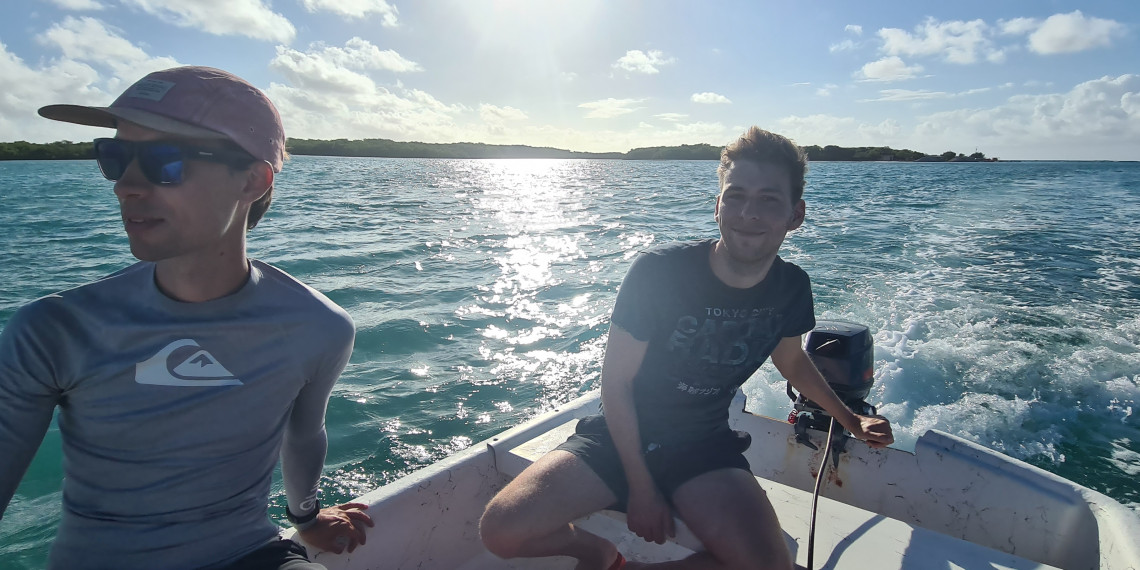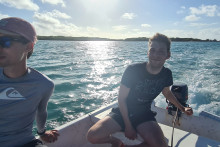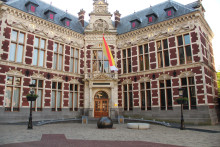We have been walking for at least an hour when PhD candidate Rik Gijsman suddenly stops. ‘The path ends here’, he says firmly. Strangely enough, this present journalist had not been aware that there was a path at all. To the untrained eye, these are just dense forests with threateningly swaying branches that leave welts on your skin. So Gijsman’s words are not particularly reassuring.
And sure enough: things get even worse. Whereas before, we at least had solid ground underneath our feet, now we have to clamber on over the thick roots of the mangrove trees. The living roots are rock-solid and can easily support an adult man. But if you should accidentally step on a dead branch, it will give away with a loud crack and you will plunge into the shallow swamp below. The water emits a scent that smells like something between rotten eggs and an open tin of sausages.
It also does not help that Gijsman and Rob van Zee, master’s student in River and Coastal Engineering, are carrying equipment with them on this trek through the mangrove forests of Bonaire. For instance, they are carrying GPS equipment on a three-metre-tall pole, which we can unscrew. Under our arms, we carry stainless steel and wooden stakes to mark locations. The equipment also includes a large coil of red rope and a long tape measure. And drinking water, lots of drinking water. Like mules, we traverse the inhospitable terrain.

The gear.
‘Whereas ecologists usually focus on the biodiversity in the mangroves, we, as engineers, prefer to think of these forests as a kind of dike’
A mangrove forest as coastal protection
What brings the Twente researchers to this unfriendly environment? In order to answer this question, you need to understand that mangrove forests are unique natural sites. Because the prop roots of mangrove trees are submerged in the water, they serve as a great shelter for young fish. Moreover, these forests are often praised for their excellent qualities with regard to coastal protection: a healthy mangrove forest forms a natural breakwater that can prevent flooding or reduce damage, among other things.
For his doctoral research, Gijsman is now trying to translate the latter claim into figures. Exactly how important is the mangrove forest for coastal protection? And how does this protection change when a forest grows or when it dies? This information should eventually yield a universal model that can estimate the protective value of mangrove forests, not just on Bonaire, but everywhere. This is sorely needed, because all over the world, these kinds of coastal areas are under pressure. Vast stretches of forest have been cut down, especially in many African and Asian countries.
‘Whereas ecologists usually focus on the biodiversity in the mangroves, we, as engineers, prefer to think of these forests as a kind of dike’, says Gijsman, who works at the Faculty of Engineering Technology. ‘When a dike is in poor condition, you reinforce it. Based on the same reasoning, you could – if possible – also restore a mangrove forest in order to keep the coast protected. In many areas, this is the best natural protection against flooding. However, if we are to use mangroves for that purpose, we first need to know the conditions in which they die or grow.’
Unforeseen obstacles
Today, Gijsman and Van Zee set off into the Lac Bay mangroves to mark out a few sections of the forest. Soon, volunteers will count the number of trees and roots here and measure their diameters. This will give much insight into the forest’s health, and denser forests make better breakwaters. It soon becomes clear that this is no easy task in this rugged terrain. The area is so densely vegetated that it is impossible to count all the trees on a one hundred square metre plot, as Gijsman had originally planned. Out of necessity, he reduces the plots to 25 square metres.

Gijsman and Van Zee demarcate a plot measuring five by five metres.
Five minutes later, Gijsman disappears into the forest, with a tape measure in his hand and some red rope to mark out the plot. He tries to walk in a straight line as best he can into the thicket, but the forest is so impenetrable here that it is hardly possible. Step by step, he gains ground. After five metres, he turns right in search of Van Zee, who is approaching him from the other side. With the utmost difficulty, he demarcates this section. Having emerged from the forest, Gijsman tells us that ‘with the exception of a single scorpion’, there are no dangerous animals crawling around. Thank goodness for that.
A bit further on, in the swampy area, the young researchers encounter another problem. Even when the forest is not that dense, counting the mangrove trees turns out to be more difficult than expected. Here, the trees have so many thick aerial roots that it is almost impossible to see which trunks belong to the same tree. You can hardly tell where one tree ends and the other one begins. Once again, the researchers are forced to improvise. They decide to allow the volunteers some leeway: they do not have to write down the exact number of trees and roots, but they can make an educated guess.

‘In the final model, we will include the conditions in which mangrove forests die or grow’
Flow model for forest restoration
‘With this information, we are going to make a vegetation map of the area’, says Gijsman shortly after, with a cup of coffee in his hand. ‘In addition, we will use GPS and our other measuring instruments to determine the altitude of the terrain and the depth of the water. When we combine this with information about the velocity of the water, the wave force and the spread of sediment, we create a very comprehensive picture of the ecosystem in and around the mangrove forest.’
After the data collection is complete, the real analysis will take place. In his thesis, Van Zee will make a flow model for the water in the mangroves, and Gijsman will subsequently expand this information with data on the vegetation development in his PhD thesis. Gijsman: ‘In the final model, we will include the conditions in which mangrove forests die or grow. And once this information is available, we hope it will be possible to create the right conditions to restore the forests.’
A diver installs a flow meter.
Tentative conclusions
Although it will be another two years before his PhD thesis is finished, Gijsman can already draw some tentative conclusions based on the raw data. For example, it would appear that trees at the back of the mangrove forest are dying because of the limited supply of water there. It is only at spring tide that the hindmost areas are supplied with fresh seawater. That is why volunteers on Bonaire have been working hard for several years now to improve the water flow in the area, and the Twente models can serve as a practical guide for this endeavour.
‘It is also striking that the mangrove forest is growing on the side of the bay that is sheltered from the wind, but not on the rougher side’, says Gijsman. It is likely that the currents and waves there are so strong that the propagules [a kind of seed – Ed.] do not get a chance to take root. Using this information, we can make predictions about the mangrove growth, also in other areas.’
This illustrates how the modern engineer looks at his task: he does not only conquer nature with large artificial constructions, but also increasingly uses natural properties to his advantage. Thus, the mangrove forest turns out to be not just a special natural site, but also an important piece of infrastructure.

Rik Gijsman’s research is part of the Mangrove-RESCUE project, for which he received a grant from the KNAW Ecology fund. UT researcher Erik Horstman received a NWO Veni grant for the project.








